|
<<=PREVIOUS |
NEXT=>> |
THE HANGING JUDGE - His Court, Jail and Gallows |

1908 Reunion of U.S. Deputy Marshals that rode for Judge Parker. The picture
was taken in front of the courthouse and jail. The
large buildings to the right and rear of the courthouse no longer exist. |
Judge Isaac Charles Parker
Isaac
Charles Parker was born in a log cabin in Belmont County, Ohio on October
15, 1838. He was admitted to the Ohio bar in 1859 at the age of 21. Soon
after he moved to St. Joseph, Missouri where he began to practice law.
In St. Joe he met Mary O'Toole. He was Methodist and she Catholic
but Isaac and Mary, known for their life-long tolerant attitudes, fell
in love and married soon after Isaac set up his practice. Two sons,
Charles and James were born to them in Missouri. It was not long before
Parker became well known as a fair and honest lawyer and a leader of his
community.
Parker was an ardent Democrat until the outbreak of the Civil War. When war started
he switched parties and for the remainder of his life he was a loyal Republican. In 1864 he was elected
state's attorney for the Twelfth Judicial Circuit of Missouri and in 1868
he became a judge of that circuit. Two years later he was elected U.S.
Representative from his district. He remained in Congress until he was
appointed as judge for the Western District of Arkansas. Parker was greatly
respected by members of both parties and when it became evident that an
incorruptible man was needed for the job, he was elected federal judge
by a significant majority of Congress. |
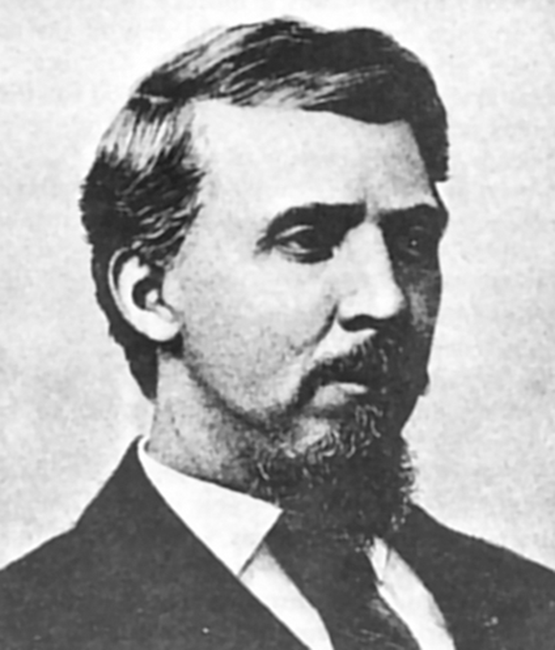
Isaac Parker when he first arrived in Fort Smith in 1875 |
No Law West of Arkansas
The man holding the position of federal Judge before Parker was William Story,
a political appointee. Story's court was corrupt from
top to bottom. The deputy marshals employed by his court were
as bad as the outlaws, and often outlaws themselves. During
his tenure the inhabitants of western Arkansas and Indian
Territory were without effective law enforcement of any kind.
The Indian territories, under the jurisdiction of the United
States Court of the Western District of Arkansas, became a
haven for outlaws. Technically whites could not own tribal
land but they could and did lease it. If they married an Indian they
became members of the tribe with the same privileges as
full-blooded tribal members. Many worked for Indians or
simply lived in the territories doing whatever was necessary
to remain there. Tribal courts had no authority over white
men or Indians of other tribes and Story's court had little
interest in enforcing the law in the Indian Nations. In reality,
there was no law west of Arkansas. Criminals swarmed into
the territory to escape justice. Once there, they had little
reason to change their ways. Many passed down their lack
of respect for the law to their offspring. As a result,
three generations of outlaws terrorized Indian Territory.
In 1874 Story resigned
to avoid impeachment and Parker was appointed. Judge
Parker and his family arrived in the dirty little frontier
town of Fort Smith in 1875. On the bench Parker was a strict
law and order judge. For the first fourteen years of his
tenure there was no appeal above his court, yet he never
let that immense power over come his sense of justice. Parker
was also a community leader in Fort Smith. During his 21
years on the bench he watched the dirty little frontier
town become a first class city on the Arkansas River. Judge
Parker helped to bring about the transformation. Considered
stern and unbending on the bench, in private life he was
respected as a kind and gentle man. |
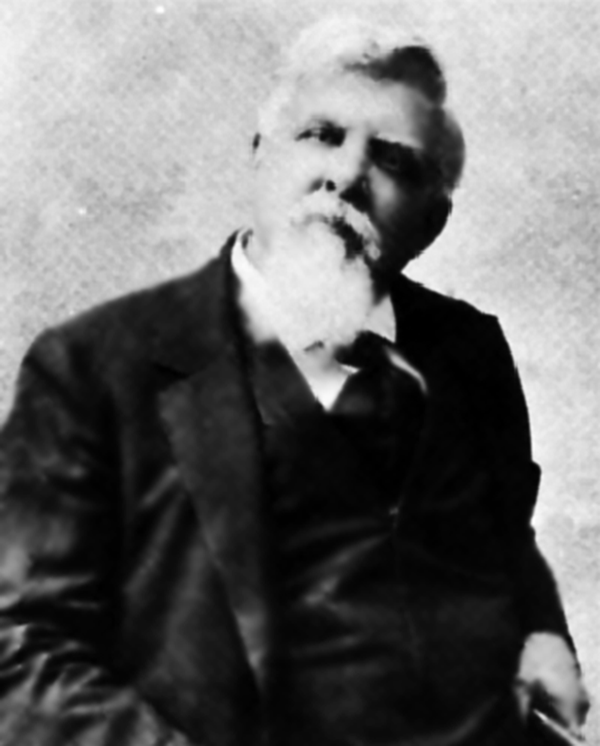 Judge Isaac Parker - 1895 |
The Hanging Judge
During his years on the bench, Judge Parker heard more than 12,000 criminal cases,
344 of them capital crimes. 160 men were convicted of rape or murder and
sentenced to death by hanging. Only about half, 79 men, actually died
on the gallows. The rest had their sentences reduced, received Presidential
pardons or commutations, had their sentences appealed and won, or died
in jail waiting execution. Parker's court was both the first and final federal court in the Western District of Arkansas.
At that time the U.S. Supreme Court did not hear appeals for capital crimes.
Appeals were heard by the same court (and judge) that tried the original
case. From 1875 to 1889 only the President of The United States could
change a sentence imposed by Parker. However, Parker was a fair man. He
occasionally granted retrials some times resulting in acquittals or reduced
sentences.
The number of executions under Parker's court was hardly excessive, given
the vast territory over which he had jurisdiction and the length of time
he was on the bench. Rampart lawlessness reigned in Indian Territory,
and the utter viciousness of the crimes merited the sentences imposed.
It was the fact that several executions were multiple hangings (at one
time six men died at the end of a rope) that Judge Parker earned the title
of "Hanging Judge" given to him by the Eastern press and the
outlaws who feared him. |
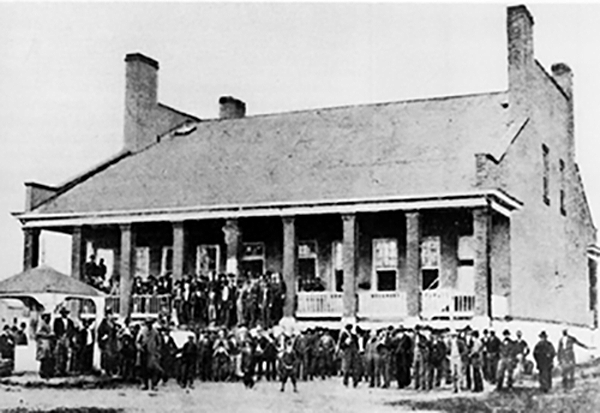 The original courthouse
The original courthouse
|
Hell On The Border - Courthouse, Jail And Gallows
From 1865 until 1871 the Court of the Western District of Arkansas was seated in Van Buren. In 1871 the court was moved to Fort Smith. By that time the old fort had been abandoned by the army and the new court moved into the officer's barracks in 1872. This was the court building that Judge Parker saw when he came to Fort Smith in 1875. On the east end of the original building was the courtroom. On the west end were offices for clerks, the U.S. Marshal and U.S. Commissioner. A hallway ran down the middle with doors to the outside and steps to ground level on both sides. An attic was used for storage and in the basement was the jail. Conditions in the old basement jail beneath the court were so bad that it was soon called "Hell on the Border". Many have assumed that the title applied to the town of Fort Smith, but it was the jail and courthouse that earned the label. The old jail was an open area with a six foot ceiling. The only toilet facilities were buckets set in the corners of the room. In the center was a large barrel cut in half that served as the jail's only wash tub. The picture below gives you an idea of the conditions in this hell hole. There was little light or ventilation and in the summer the heat was unbearable. The "new" courthouse and jail was built in the late 1880's incorporating parts of the old building. The old "hell hole" is perserved today as it looked in its glory days. The court and jail moved into its new quarters in 1890 towards the end of Parker's term. After the federal court was moved out of Fort Smith the building was used as a courthouse and jail until 1917 when they moved into a newly constructed city building downtown. |
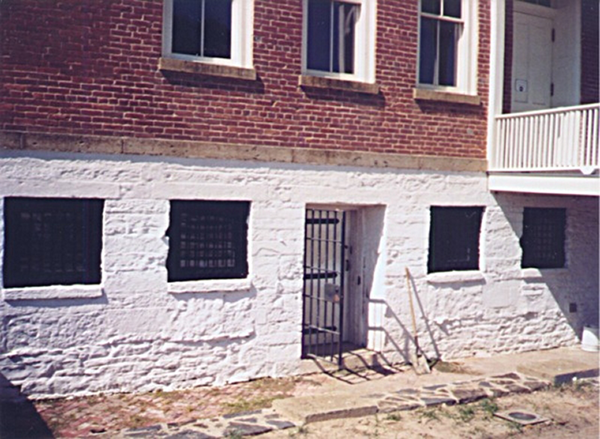 |
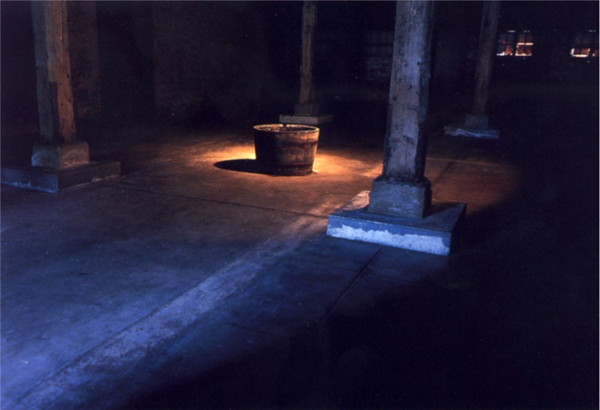 |
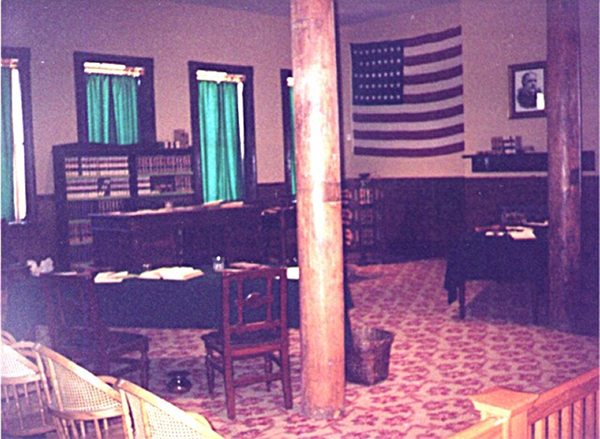 |
The jail a claustrophobic dark open space with almost no ventilation. It was often crowded with male violent offenders to simple misdemeanors. It was indeed an unsavory place. Its fitting name was given by eastern newspapers. All detainees except women were held in this stink hole. The petty thief shared
his misery with the worst of murderers and rapists. The old jail
is preserved today at the Fort Smith National Historic Site, although
it smells much better and looks much cleaner. One of the rangers
at the site once told me when I last visited the sight 15 or so years ago that there are discussions about giving it back
much of its old look so people can get a real idea of what Hell on the
Border was really like. I think that is a good idea, as long as they
do not attempt to recreate the original smells. The courtroom was immediately above the jail. The odor was not confined to the basement jail. It drifted up into Parker's court room. In warmer weather even opening all the windows did not help. When the odor was unbearable court would be adjourned.
In 1887 conditions in the old building were
so deplorable that Congress finally appropriated money needed to improve
the court. A second story was added to the original building and
a new jail wing was built on the west end, giving the building the look
it has today. The basement jail was turned into a storage
area and prisoners were moved to the new jail wing. Today Judge Parker's
courtroom (left) has been restored by the National Park service to how it appeared in the 1870's and 1880's, minus odors. |
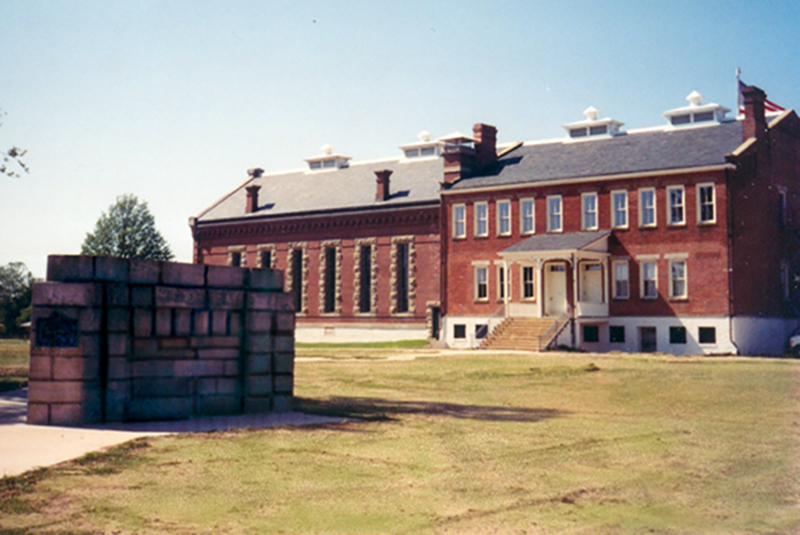
The expanded courthouse with new jail wing (on the left). The bulding was used as a federal court from
1888-1896.
The upper floor was administrative and legal offices.
The wall in the left foreground is a reconstruction of a tiny part
of original fortress wall. |
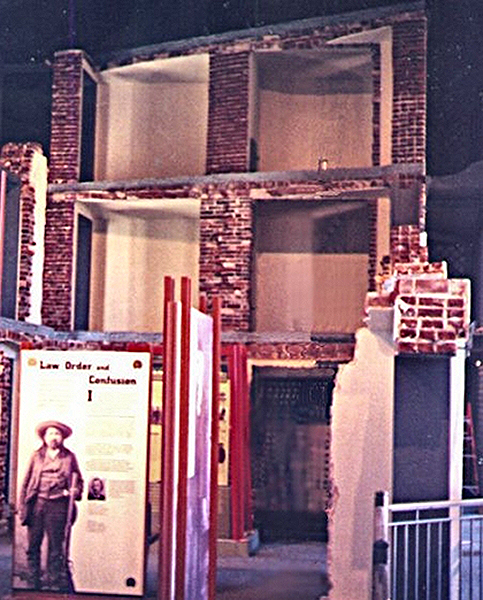
A reconstruction cut-away of the cell block in the jail wing at the
Fort Smith National Historical Site. There were three tiers of eight cells each. Each cell was designed to hold two men.
|
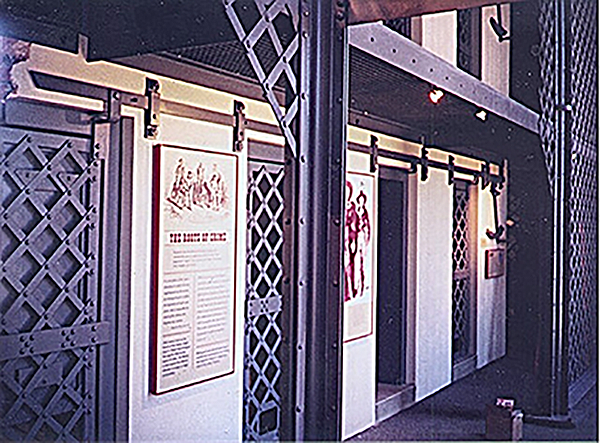
The jail cells were surrounded by an iron cage enclosing the entire block. This was called the Bull Pen. A narrow walk-way surrounded the Bull Pen on which the guards patrolled the cell block. The cage has been partially cut away (far right) to give visitors to the museum access for a better view of the jail cells. |
The Gallows
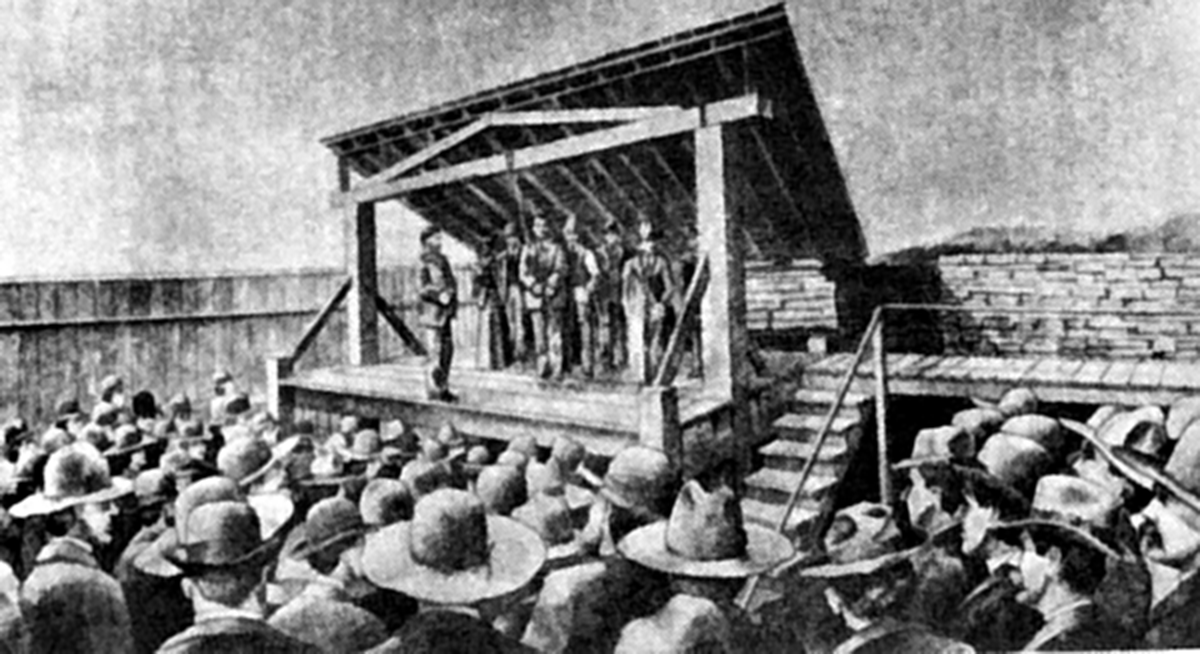
A contemporary drawing for a newspaper of outlaw Cherokee Bill's 1896 hanging. No photographs were allowed.
When asked if he had any last words Bill replied, "I came here to die, not make a speach." |
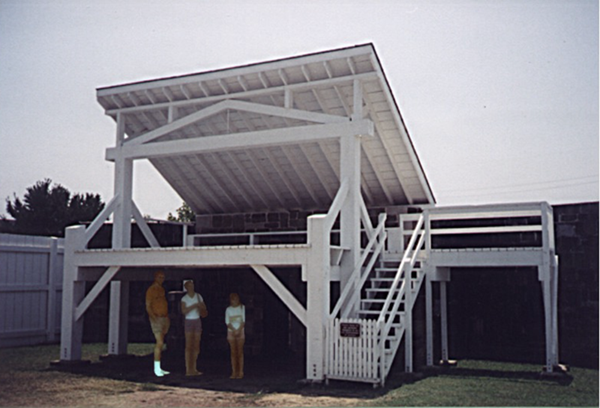
The replica of the 1886 gallows |
The old gallows was used from Parker's appointment in 1875 until a new gallows was constructed in 1886. Up to twelve men
could be executed simultaneously on the new gallows, although six was the most ever executed
at once. These multiple hangings lead the Eastern press to label Judge Parker, "The hanging judge". A roof was constructed over the gallows so that the executions
could go on in any weather and a wooden wall was built around the yard
to limit the number of people who could witness the executions.
To gain entrance, you had to obtain a ticket from the Marshal's office. The drawing above of Cherokee Bill's hanging in 1896 was based on
a snap shot taken against the rules by a young man with a Brownie camera.
A newspaper artist made the sketch using the snap shot. The original photograph
has long since disappeared.
At first new gallows had
no roof over it and no walls surrounding the yard. The lower part
of the gallows was covered with wood planking to conceal the bodies of
the hanged men, but these were later removed to satisfy the morbid curiosity
of the crowds. Hanging day always drew a big crowd with sometimes
thousands attending, many traveling from as far as a hundred miles to
witness the scene. Eventually, the court decided that the hangings were becoming too much of a public
spectacle and public hangings were discontinued. In the more than twenty years as a
federal court with hundreds of men convicted of capital crimes, only 79
actually died on the gallows. |
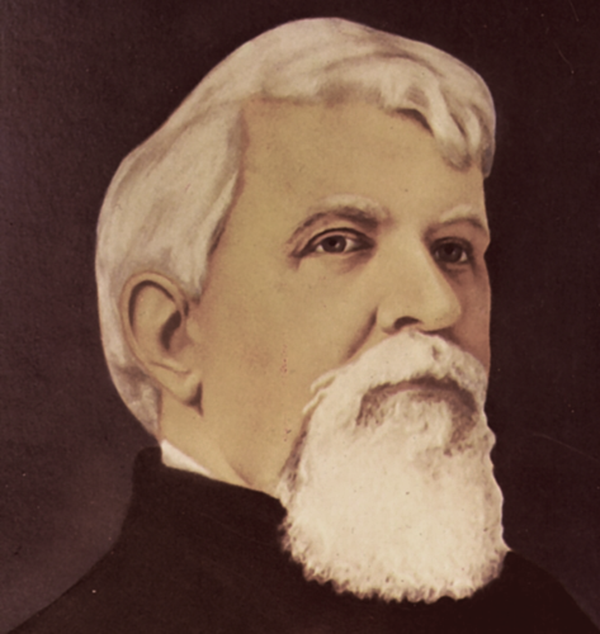
Painting of Judge Parker ca. 1895 |
Gradually, Parker's jurisdiction shrank as more courts were given authority over
parts of Indian Territory. In September 1896 Congress closed the federal court for The Western District of Arkansas.
In 1890 the court moved down the street to a new federal court building,
but the new jail continued to be used to house prisoners as a federal prison.
In the summer of 1896 Parker became too ill to sit on the bench and other
judges took over his duties. On November 17, 1896 Judge Parker died, only six weeks
after the Court of the United States for the Western District of Arkansas
was adjourned for the last time. He is buried in the National Cemetery near downtown Fort Smith and
within easy walking distance of the National Historical Site.
After 1917 time it was
used for a variety of purposes. In the 1930's it housed the Fort Smith Federated Welfare Association
and for a time as a warehouse. The city took it over
and operated it as a museum for Parker's court until it was designated
a National Historic Site. Today the grounds and buildings are operated by the National Park
Service. It had undergone extensive renovation by the park service, due partly to damage from a
tornado that struck Fort Smith in 1996, but mostly due to its historical
significance. It is now open to the public and it is a destination
for tourist from all over and not just a local landmark. |
| <<=PREVIOUS |
NEXT=>> |








